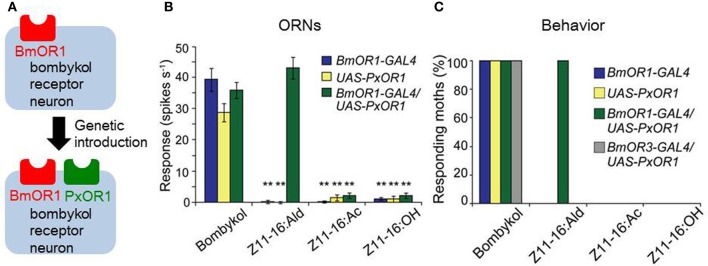Figure 6.

Labeled-line coding of bombykol information. (A) A GAL4 line with putative BmOR1 promoter sequences (BmOR1-GAL4) and an effector line expressing PxOR1 under the control of the UAS sequence were generated, and crossed to induce the expression of PxOR1 in bombykol-sensitive ORNs. (B) Single sensillum responses of bombykol-sensitive ORNs. Bombykol-sensitive ORNs of BmOR1-GAL4/UAS-PxOR1 that express PxOR1 responded to Z-11-hexadecenal (Z11-16:Ald) as well as bombykol. Z-11-hexadecenyl acetate (Z11-16:Ac) and Z-11-hexadecenol (Z11-16:OH) are pheromone components of the diamondback moth, but are not ligands for PxOR1. **p < 0.01 compared with responses of the corresponding line stimulated with bombykol; Scheffe's F test. (C) Percentages of male moths that exhibit pheromone-source searching behavior. Artificial activation of bombykol-sensitive ORNs by Z11-16:Ald triggered the behavior, demonstrating that the activation of BmOR1-expressing bombykol-sensitive ORNs is sufficient for the initiation of pheromone-source searching behavior. Expression of PxOR1 in bombykal-sensitive ORNs by a BmOR3 promoter-GAL4 line (BmOR3-GAL4/UAS-PxOR1) did not confer behavioral responsiveness to Z11-16:Ald. (modified from Sakurai et al., 2011).
